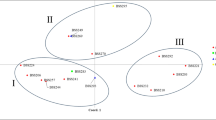Abstract
Seeds and plants of wild type Lupinus albus are bitter and contain high level of alkaloids. During domestication, at least three genes conferring low-alkaloid content were identified and incorporated into commercial varieties. Australian lupin breeders exclusively utilize one of these sweetness genes, “pauper”, in all varieties to prevent possible bitterness contamination via out-crossing. A cross was made between a sweet variety Kiev Mutant (containing pauper gene) and a bitter type landrace P27174, and the population was advanced into F8 recombinant inbred lines (RILs). Twenty-four plants representing sweetness and bitterness were subjected to DNA fingerprinting by the microsatellite-anchored fragment length polymorphism (MFLP) technique. A dominant polymorphism was discovered in an MFLP fingerprint. The MFLP marker was converted into a co-dominant, sequence-specific, simple PCR-based marker. Linkage analysis by the software program MapManager with marker score data and alkaloid phenotyping data from a segregating population containing 190 F8 RILs indicated that the marker is linked to the pauper gene at the genetic distance of 1.4 centiMorgans (cM). This marker, which is designated as “PauperM1”, is capable of distinguishing the pauper gene from the other two low-alkaloid genes exiguus and nutricius. Validation on germplasm from the Australian lupin breeding program showed that the banding pattern of the marker PauperM1 is consistent with the alkaloid genotyping on a wide range of domesticated varieties and breeding lines. The PauperM1 marker is now being implemented for marker assisted selection in the Australian albus lupin breeding program.


Similar content being viewed by others
References
Clements JC, Buirchell BJ, Yang H, Smith PMC, Sweetingham MW, Smith CG (2005) Chapter 9, Lupin. In: Singh RJ, Jauhar PP (eds) Genetic resources, chromosome engineering, and crop improvement. Vol 1, grain legumes. CRC Press, Florida, pp 231–323
Cowling WA, Buirchell BJ, Tapia ME (1998) Promoting the conservation and use of underutilized and neglected crops, Lupins—Lupinus spp. IPK, Gatersleben/IPGRI, Rome
Eagles HA, Bariana HS, Ogbonnaya FC, Rebetzke GJ, Hollamby GJ, Henry RJ et al (2001) Implementation of markers in Australian wheat breeding. Aust J Agric Res 52:1349–1356. doi:10.1071/AR01067
Faluyi MA, Williams W (1981) Studies on the breeding system in lupin species: (a) self- and cross-compatibility in three European lupin species, (b) percentage outcrossing in Lupinus albus. Z Pflanzenzuchtg 87:233–239
Gladstones JS (1970) Lupins as crop plants. Field Crop Abstr 23:123–148
Gupta PK, Varshney RK, Sharma PC, Ramesh B (1999) Molecular markers and their applications in wheat breeding. Plant Breed 118:369–390. doi:10.1046/j.1439-0523.1999.00401.x
Harrison JEM, Williams W (1982) Genetical control of alkaloids in Lupinus albus. Euphytica 31:357–364. doi:10.1007/BF00021651
Harrison JEM, Williams W (1983) The control of alkaloid by mutant alleles in Lupinus albus and Lupinus angustifolius. Z Pflanzenzuchtg 90:32–41
Holland JB (2004) Implementation of molecular markers for quantitative traits in breeding programs—challenges and opportunities. In: Proceedings of the 4th international crop science congress, Brisbane, Australia, 26 Sept–1 Oct 2004 (www.cropscience.org.au)
Hondelmann W (1984) The lupin—ancient and modern crop plant. Theor Appl Genet 68:1–9. doi:10.1007/BF00252301
Huyghe C (1997) White lupin. Field Crops Res 53:147–160. doi:10.1016/S0378-4290(97)00028-2
Kurlovich BS (2002) Genetics of lupins. In: Kurlovich BS (ed) Lupins: geography, classification, genetic resources and breeding. Intan, St. Petersburg, Russia. ISBN 5-86741-034-X
Manly KF, Cudmore RH Jr, Meer JM (2001) MapManager QTX, cross-platform software for genetic mapping. Mamm Genome 12:930–932. doi:10.1007/s00335-001-1016-3
Raeder U, Broda P (1985) Rapid preparation of DNA from filamentous fungi. Lett Appl Microbiol 1:17–20. doi:10.1111/j.1472-765X.1985.tb01479.x
Sharp PJ, Johnston S, Brown G, McIntosh RA, Pallotta M, Carter M et al (2001) Validation of molecular markers for wheat breeding. Aust J Agric Res 52:1357–1366. doi:10.1071/AR01052
Snape JW (2004) Challenges of integrating conventional breeding and biotechnology: a personal view! Proceedings of the 4th international crop science congress, Brisbane, Australia, 26 Sept–1 Oct 2004 (www.cropscience.org.au)
Von Baer E, Perez I (1991) Quality standard propositions for commercial grain of white lupin (Lupinus albus). In: Proceedings of the 6th international lupin conference Temuco, International lupin association, Chile, pp 158–167
Vos P, Hogers R, Bleeker M, Reijans M, Lee T, Hornes M et al (1995) AFLP: a new technique for DNA fingerprinting. Nucleic Acids Res 23:4407–4414. doi:10.1093/nar/23.21.4407
Witsenboer H, Vogel J, Michelmore RW (1997) Identification, genetic localization, and allelic diversity of selectively amplified microsatellite polymorphic loci in lettuce and wild relatives (Lactuca spp.). Genome 40:923–936. doi:10.1139/g97-119
Workman PL, Allard RW (1962) Population studies in predominantly self-pollinated species, III. A matrix model far mixed selfing and random outcrossing. Proc Natl Acad Sci USA 48:1318–1325. doi:10.1073/pnas.48.8.1318
Yang H, Sweetingham MW, Cowling WA, Smith PMC (2001) DNA fingerprinting based on microsatellite-anchored fragment length polymorphisms, and isolation of sequence-specific PCR markers in lupin (Lupinus angustifolius L.). Mol Breed 7:203–209. doi:10.1023/A:1011363205557
Yang H, Shankar M, Buirchell BJ, Sweetingham MW, Caminero C, Smith PMC (2002) Development of molecular markers using MFLP linked to a gene conferring resistance to Diaporthe toxica in narrow-leafed lupin (Lupinus angustifolius L.). Theor Appl Genet 105:265–270. doi:10.1007/s00122-002-0925-1
Yang H, Boersma JG, You M, Buirchell BJ, Sweetingham MW (2004) Development and implementation of a sequence-specific PCR marker linked to a gene conferring resistance to anthracnose disease in narrow-leafed lupin (Lupinus angustifolius L.). Mol Breed 14:145–151. doi:10.1023/B:MOLB.0000038003.49638.97
Yang H, Renshaw D, Thomas G, Buirchell B, Sweetingham M (2008) A strategy to develop molecular markers applicable to a wide range of crosses for marker assisted selection in plant breeding: a case study on anthracnose disease resistance in lupin (Lupinus angustifolius L.). Mol Breed 21:473–483. doi:10.1007/s11032-007-9146-2
You M, Boersma JG, Buirchell BJ, Sweetingham MW, Siddique KHM, Yang H (2005) A PCR-based molecular marker applicable for marker-assisted selection for anthracnose disease resistance in lupin breeding. Cell Mol Biol Lett 10:123–134
Acknowledgment
This research was supported by the Grain Research and Development Corporation (Australia) project DAW0102.
Author information
Authors and Affiliations
Corresponding author
Rights and permissions
About this article
Cite this article
Lin, R., Renshaw, D., Luckett, D. et al. Development of a sequence-specific PCR marker linked to the gene “pauper” conferring low-alkaloids in white lupin (Lupinus albus L.) for marker assisted selection. Mol Breeding 23, 153–161 (2009). https://doi.org/10.1007/s11032-008-9222-2
Received:
Accepted:
Published:
Issue Date:
DOI: https://doi.org/10.1007/s11032-008-9222-2




